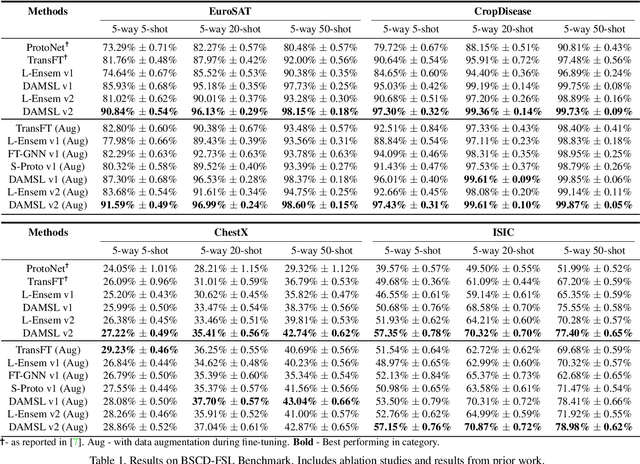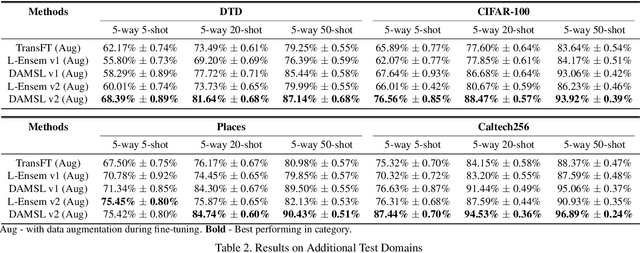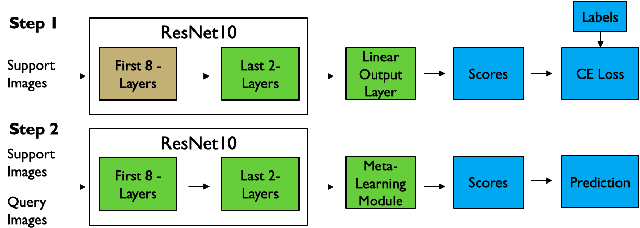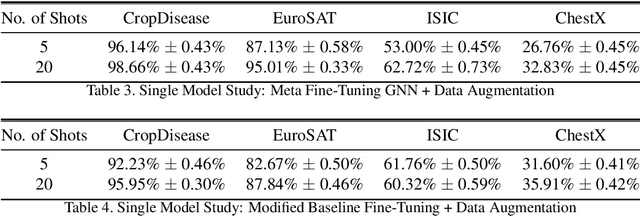John Cai
DAMSL: Domain Agnostic Meta Score-based Learning
Jun 06, 2021



Abstract:In this paper, we propose Domain Agnostic Meta Score-based Learning (DAMSL), a novel, versatile and highly effective solution that delivers significant out-performance over state-of-the-art methods for cross-domain few-shot learning. We identify key problems in previous meta-learning methods over-fitting to the source domain, and previous transfer-learning methods under-utilizing the structure of the support set. The core idea behind our method is that instead of directly using the scores from a fine-tuned feature encoder, we use these scores to create input coordinates for a domain agnostic metric space. A graph neural network is applied to learn an embedding and relation function over these coordinates to process all information contained in the score distribution of the support set. We test our model on both established CD-FSL benchmarks and new domains and show that our method overcomes the limitations of previous meta-learning and transfer-learning methods to deliver substantial improvements in accuracy across both smaller and larger domain shifts.
SB-MTL: Score-based Meta Transfer-Learning for Cross-Domain Few-Shot Learning
Dec 03, 2020



Abstract:While many deep learning methods have seen significant success in tackling the problem of domain adaptation and few-shot learning separately, far fewer methods are able to jointly tackle both problems in Cross-Domain Few-Shot Learning (CD-FSL). This problem is exacerbated under sharp domain shifts that typify common computer vision applications. In this paper, we present a novel, flexible and effective method to address the CD-FSL problem. Our method, called Score-based Meta Transfer-Learning (SB-MTL), combines transfer-learning and meta-learning by using a MAML-optimized feature encoder and a score-based Graph Neural Network. First, we have a feature encoder with specific layers designed to be fine-tuned. To do so, we apply a first-order MAML algorithm to find good initializations. Second, instead of directly taking the classification scores after fine-tuning, we interpret the scores as coordinates by mapping the pre-softmax classification scores onto a metric space. Subsequently, we apply a Graph Neural Network to propagate label information from the support set to the query set in our score-based metric space. We test our model on the Broader Study of Cross-Domain Few-Shot Learning (BSCD-FSL) benchmark, which includes a range of target domains with highly varying dissimilarity to the miniImagenet source domain. We observe significant improvements in accuracy across 5, 20 and 50 shot, and on the four target domains. In terms of average accuracy, our model outperforms previous transfer-learning methods by 5.93% and previous meta-learning methods by 14.28%.
Cross-Domain Few-Shot Learning with Meta Fine-Tuning
Jun 02, 2020



Abstract:In this paper, we tackle the new Cross-Domain Few-Shot Learning benchmark proposed by the CVPR 2020 Challenge. To this end, we build upon state-of-the-art methods in domain adaptation and few-shot learning to create a system that can be trained to perform both tasks. Inspired by the need to create models designed to be fine-tuned, we explore the integration of transfer-learning (fine-tuning) with meta-learning algorithms, to train a network that has specific layers that are designed to be adapted at a later fine-tuning stage. To do so, we modify the episodic training process to include a first-order MAML-based meta-learning algorithm, and use a Graph Neural Network model as the subsequent meta-learning module. We find that our proposed method helps to boost accuracy significantly, especially when combined with data augmentation. In our final results, we combine the novel method with the baseline method in a simple ensemble, and achieve an average accuracy of 73.78% on the benchmark. This is a 6.51% improvement over existing benchmarks that were trained solely on miniImagenet.
 Add to Chrome
Add to Chrome Add to Firefox
Add to Firefox Add to Edge
Add to Edge